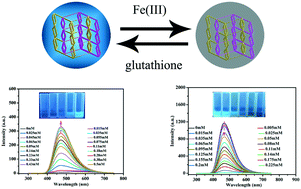A water-stable zinc(ii)–organic framework as an “on–off–on” fluorescent sensor for detection of Fe3+ and reduced glutathione†
Abstract
As an important biomarker, the level of reduced glutathione in serum is vital for human health. A novel 3D metal–organic framework with excellent photoluminescence properties, formulated as [Zn3(TNB)(DPE)2]·2H2O·DMF (1) (H3TNB = 4,4′,4′′-nitrilotribenzoic acid and DPE = 1,2-di(4-pyridyl)ethylene), was constructed by a solvothermal reaction. Complex 1 exhibits high water stability and pH stability in aqueous solution. It can detect Fe3+ and Pb2+ as a “turn-off” fluorescent probe in PBS solution with high sensitivity and selectivity. The detection limits for Fe3+ and Pb2+ are about 3.40 × 10−7 M and 4.59 × 10−7 M, respectively. Compared to Pb2+, Fe3+ has stronger oxidizability, and can be reduced to Fe2+ with the addition of a reductant, causing the fluorescence intensity of the Fe3+@1 system to significantly recover while that of the Pb2+@1 system has little change. Thus, the Fe3+@1 system exhibits a fluorescence “turn-on” signal after adding reduced glutathione (GSH) due to the reduction reaction, which indicates that complex 1 can be designed as an “on–off–on” fluorescent probe to detect Fe3+ ions and reduced GSH. The mechanism for fluorescence recovery is the elimination of the FRET process between Fe3+ and complex 1. In view of this reversible detection event, a two-input molecular logic gate was constructed. In addition, the “on–off–on” fluorescent sensor can be successfully applied to detection of reduced GSH in serum and fruits and vegetables with a high recovery range and low relative standard deviations (RSDs). To the best of our knowledge, this is the first example of a MOF-based probe for reduced GSH recognition by fluorescence “on–off–on” in PBS solution.

- This article is part of the themed collection: Coordination Networks


 Please wait while we load your content...
Please wait while we load your content...